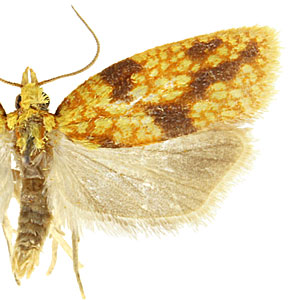Adult Recognition

FWL: 6.5-10.0 mm
Forewings are bright yellow with orange to purplish markings. Wing pattern is variable, but most individuals have two marks along the costa and a "V" shaped mark extending from the costa to dorsum. This pattern creates the appearance of an "X" when the moth is resting with its wings folded. Other individuals may be nearly patternless or have extensive reticulations. Hindwings are light gray to grayish brown.
Some adult forms are similar to other species of Sparganothis, including S. lycopodiana and S. unifasciana.
Larval Morphology

Late instar larvae are approximately 13-17 mm long. The abdomen is yellowish to grayish green with lighter, conspicuous pinacula. The head is yellowish to reddish brown with antennae that are white basally and black distally. The prothoracic shield is concolorous with the abdomen and is edged laterally (and possibly posterolaterally) with black. An anal comb is present with 6-9 teeth.
Biology

Sparganothis sulfureana completes two generations per year. Adults are present from mid-June to July and August to September.
Females lay eggs in masses that contain 20-50 individual eggs on the upper surface of leaves. Larvae of the first (spring) generation feed on flower buds and leaves; those of the second (summer) generation feed on leaves and fruit. Overwintering occurs as an early instar larva in leaf debris on the ground.
Host plants
Larvae of S. sulfureana are polyphagous and have been recorded feeding on plants in nearly 20 families. This species is best known as a serious pest of cranberry, where it causes damage to both leaves and fruit.
| Family | Genus/species | Common name |
| Apiaceae | Apium graveolens L. | wild celery |
| Apiaceae | Hydrocotyle L. | hydrocotyle |
| Asteraceae | Arctium L. | burdock |
| Asteraceae | Aster L. | aster |
| Asteraceae | Erigeron annuus (L.) Pers. | eastern daisy |
| Asteraceae | Helianthus L. | sunflower |
| Asteraceae | Solidago L. | goldenrod |
| Asteraceae | Symphyotrichum novae-angliae (L.) G.L. Nesom | New England aster |
| Clusiaceae | Hypericum L. | St. Johnswort |
| Clusiaceae | Hypericum perforatum L. | common St. Johnswort |
| Cupressaceae | Thuja occidentalis L. | arborvitae |
| Ericaceae | Vaccinium L. | blueberry |
| Ericaceae | Vaccinium L. | cranberry |
| Ericaceae | Vaccinium macrocarpon Aiton | cranberry |
| Fabaceae | Gleditsia L. | locust |
| Fabaceae | Medicago sativa L. | alfalfa |
| Fabaceae | Phaseolus lunatus L. | sieva bean |
| Fabaceae | Robinia L. | locust |
| Fabaceae | Trifolium L. | clover |
| Fabaceae | Trifolium pratense L. | red clover |
| Lamiaceae | Mentha L. | mint |
| Lamiaceae | Monarda fistulosa L. | wild bergamot |
| Liliaceae | Lilium L. | lily |
| Onagraceae | Oenothera L. | evening primrose |
| Pinaceae | Abies balsamea (L.) Mill. | balsam fir |
| Pinaceae | Larix Mill. | larch |
| Pinaceae | Picea glauca (Moench) Voss | white spruce |
| Pinaceae | Pinus banksiana Lamb. | jack pine |
| Pinaceae | Pinus resinosa Aiton | red pine |
| Pinaceae | Pinus rigida Mill. | pitch pine |
| Pinaceae | Pinus strobus L. | eastern white pine |
| Pinaceae | Pinus sylvestris L. | Scots pine |
| Pinaceae | Pinus L. | pine |
| Poaceae | Zea mays L. | corn |
| Ranunculaceae | Ranunculus L. | buttercup |
| Rosaceae | Crataegus L. | hawthorn |
| Rosaceae | Fragaria L. | strawberry |
| Rosaceae | Malus Mill. | apple |
| Rosaceae | Prunus virginiana L. | chokecherry |
| Rutaceae | Citrus L. | citrus |
| Salicaceae | Salix L. | willow |
| Santalaceae | Comandra umbellata (L.) Nutt. | bastard toadflax |
| Scrophulariaceae | Penstemon Schmidel | beardtongue |
| Ulmaceae | Ulmus americana L. | American elm |
| Verbenaceae | Verbena L. | vervain |
| Vitaceae | Vitis L. | grape |
| Vitaceae | Vitis vinifera L. | wine grape |
Distribution

Sparganothis sulfureana is widespread in eastern North America. There are also records from the Pacific Northwest.
References

Beckwith, C. S. 1938. Sparganothis sulfureana Clem., a cranberry pest in New Jersey. Journal of Economic Entomology. 31: 253-256.
Chapman, P. J. and S. E. Lienk. 1971. Tortricid fauna of apple in New York (Lepidoptera: Tortricidae); including an account of apple's occurrence in the state, especially as a naturalized plant. Spec. Publ. Geneva, NY: New York State Agricultural Experiment Station. 122 pp.
Landry, J-F., M. Roy and C. Turcotte. 2002. Cranberry pests of Quebec, an identification guide. Agriculture and Agri-Food Canada, Ottawa, Ontario. 117 pp.
MacKay, M. R. 1959. Larvae of the North American Olethreutidae (Lepidoptera). Canadian Entomologist Supplement 10: 1-338.






